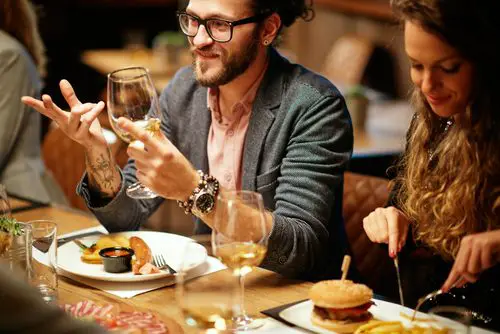What to drink on Burns Night?
Traditionally whisky is drunk with haggis on Burns Night but I prefer my whisky after the meal. To my mind we should toast the bard with Claret.
Burns would have often raised a glass of Claret as a toast.
Clarets to pair with Haggis:
It’s wise to choose a Claret that won’t overpower your haggis. You’ll need a wine that is well balanced with good structure. Overly tannic, oaky wines or fruit forward wines with high acidity will not do your haggis justice.
A wine that is too tannic or oaky will make your mouth feel dry and can make the haggis taste bitter; a wine that is too fruity or acidic will either mask the flavour of the haggis or give it a metallic aftertaste. A medium bodied, mellow red Bordeaux (Claret) has smooth tanins, layered flavours of dark berry fruits with subtle hints of spice; making it a great match for haggis.
Chateau Pessan: Fuller bodied Claret from Graves with superb balance and structure. Pessan compliments fatty lamb dishes and enhances the flavours. £15.99 – currently on offer at £13.99*Chateau Chadeuil: Medium bodied Claret. This is a wine that has been produced with good food in mind. It really blossoms with lamb, game and peppery dishes so would be ideal with haggis. £6.99*
Chateau Rauzan Segla: This is a gorgeous Grand Cru Classe Margaux (2nd Growth). A top notch Claret, multi layered and multi dimensional, it is stunning with traditional, richly flavoured fayre. £34.99*
* Prices current at the time of writing.
Burns – Knee Deep in Claret
Famous the world over as the author of ‘Auld Lang Syne,’ you might think Robert Burns’ favourite tipple was a wee dram of whisky but we know he enjoyed Claret from his poems and songs.
Burns himself was never a man to do things by halves as you can tell from his song ‘Gae Bring Tae Me A Pint O’Wine’.
His poem ‘The Whistle’ was written about a drinking contest, witnessed by Burns, between 3 landed gentlemen to see who could drink the most Claret and still be able to blow a black ebony whistle (which was kept as the prize). It’s said the winner drank 8 bottles!
The Auld Alliance – Scotland’s love affair with Bordeaux
The Scots love of Claret is tied into the Auld Alliance between Scotland and France (which goes right back to 1295). One of the benefits of the Alliance for the Scots was that Scottish merchants had the privilege of selecting the pick of France’s finest wines: those from Bordeaux. This privilege was eagerly protected for hundreds of years, much to the annoyance of the English.
In 1594 Scots masquerading as Frenchmen on the high seas captured King Henry VIIIs entire wine fleet for that year. The wine from the 16 vessels was sold in Scotland (but not at Edinburgh as the English Ambassador had just arrived there), instead the loot was transported to Aberdeen.
The Wine Quay of Leith was the hub of the wine trade and from there Claret made its way across Scotland. It’s said that in the 13thcentury there was not a tavern in Edinburgh that did not sell Claret, nor a noble household that did not stock it. Thanks to wars between England and France the Scots sometimes turned to other means of acquiring their favourite drink.
The Scottish Chateaux of Bordeaux
They are very proud of their Scottish ancestry and one of the three brothers currently running the business is named Ivanhoe. Esme Johnston owns Chateau de Sours and Jean-Marie Johnston continues the family tradition as a wine merchant at Chateau Malecot in Pauillac.Bordeaux became home to a lively colony of Scots trading in wines who settled there, establishing their own vineyards, buying chateaux and establishing themselves as wine merchants in the epicentre of Bordeaux’s wine trade, the Quai des Chartrons. Today, Nathaniel Johnston & Fils (est 1734) is the only surviving Scottish wine merchant on the Quai.
In the mid 1800s the Johnstons were part owners of Premier Cru (1st Growth) Chateau Latour and also acquiredChateaux Ducru Beaucaillou (2nd Growth Saint Julien), Phelan Segur (Cru Bourgeois Saint Estephe), Dauzac (5thGrowth Margaux) and Lascombes (2nd Growth Margaux).The Scots became important players in the world of Grand Cru Classe; owning some prestigious chateaux.
However the Johnstons were not the only Scots to purchase chateaux in Bordeaux:
Chateau Brown (Pessac Leognan) takes its name from John Lewis Brown, who moved to Bordeaux from Scotland in the late 18th century, He also owned Chateaux Cantenac Brown (3rdGrowth Margaux) and Boyd Cantenac (3rd Growth Margaux).Chateau Smith Haut Lafitte (Pessac Leognan) takes the ‘Smith’ part of its name from a navigator and wine merchant named George Smith who purchased the estate in 1720. He must have been quite an adventurer as the story has it that he eloped from Scotland having fallen in love with a local peasant girl in Scotland named Elisabeth Lewis
So, as you can see, Bordeaux owes part of its heritage to Scotland. Let’s drink to thatChateau Certan de May (Pomerol) takes its name from the Scottish Demay family who settled in France during the Middle Ages. They were masters of the fief of Certan which also included Chateau Certan Giraud (now Hosanna) and Vieux Chateau Certan.

